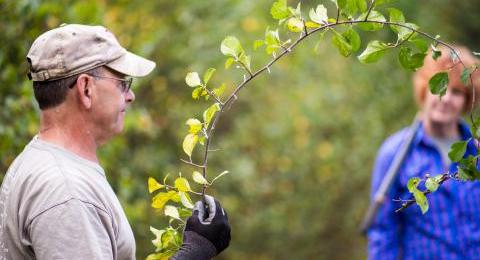
People who are aware of the problems associated with invasive plants can end up getting discouraged, once they realize that yes, they are all over the place. But don’t get discouraged! The good news is that they are not everywhere in New Hampshire, and there are options for towns, conservation groups, private landowners, and public agencies to actively work to control invasive plants.
There are three broad categories for controlling invasive plants - biological, chemical, and mechanical. The method you use will be based on many factors including the plant species you are trying to control, the size and status of the infestation, the budget and time you have available, your goals and values as a landowner, the availability of assistance or volunteers, and more. Many times, a combination of control methods is warranted.
Biological control usually utilizes plant diseases or insect predators, typically from the targeted species’ home range, to eat or kill an invasive plant. Currently, the only plant on the NH state list that are sanctioned to use biologic control methods is purple loosestrife.
Chemical options involve the use of herbicides for controlling invasive plants. In many cases, herbicides are considered the most effective and resource-efficient tool to treat invasive species. Many invasive plants re-sprout very aggressively when cut. When applied correctly, chemical herbicides, especially when combined with cutting, can dramatically reduce re-sprouting. It’s important to know that there are rules and regulations associated with herbicide use that are in place to protect both the person applying the chemical and the environment.
Using biological and chemical control methods can be expensive and, in some cases, not appealing options; for example, near sensitive wetland areas. For many landowners, mechanical control of invasive plants is a good option, particularly where volunteers can lend a hand. Depending on the plant, there are different mechanical options including weed wrenches (and similarly designed tools), hand pulling, smothering, repeated cutting or mowing, girdling, and even prescribed fire in some cases.
Planning and prioritizing your invasive plant control is important for projects to be successful. There are several strategies that can help you prioritize where to start managing invasives on your land or in your community. Protecting priority habitats, working downstream, starting with small populations, and considering the surrounding landscape are all approaches that can help to ensure a more successful project. Picking Our Battles: Planning Successful Invasive Plant Management Projects, a statewide strategic prioritization plan for the control of upland, wetland, and intertidal invasive plant species, has detailed information on these strategies and more.
More Information
- Read more about Methods of Control for Managing Invasive Plants
- Learn about methods for control of specific invasive plants in New Hampshire
- Visit wildlife.state.nh.us/invasives/ to access the Picking Our Battles Handbook
- Visit nhinvasives.org for more information on invasive plants in New Hampshire, methods for control, and disposal recommendations


